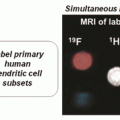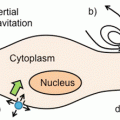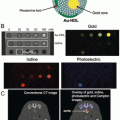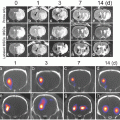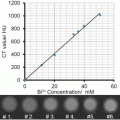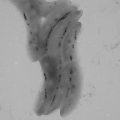Fig. 1
Extracellular vesicles can interact with neighbor cells delivering their cargo in a homotypic cell transfer (1) or in a heterotypic cell transfer (2). Vesicles may also circulate (3) and be uptaken by distal cells (4)
Formerly considered as cellular dust [8], EVs are now recognized as active players participating in homeostasis and disease [9]. Indeed, EVs act as biological effectors in physiologic processes, such as coagulation [10], immune response [11], pregnancy [12], as well as pathologic ones related to infection [13] and cancer [14, 15]. If EVs play a pivotal role in the regulation of physiological and pathological processes, it is because they are competent to mediate intercellular communication via the transfer of proteins and genetic information to recipient cells.
In addition to the intrinsic properties, EVs may be engineered to display exogenous imaging and therapeutic properties. The possibility of customizing EVs with exogenous imaging tracers and therapeutic drug/nanoparticles has opened up a wide range of exciting perspectives. On the one side, there is an enormous need to decipher the complex fate of EVs and decode their trafficking in the organism. The design of EV displaying imaging tracers will assist in the understanding of their biodistribution and interplay with recipient cells, shedding light on their role in mechanisms related both to homeostasis and disease. On the other side, EV loading with drugs, nucleic acids, or heating nanoparticles represents a unique opportunity to translate EVs into intrinsically biocompatible bio-inspired therapeutic delivery systems. Indeed, EVs feature advantageous attributes of delivery vehicles. First of all, they represent the most physiological carrier choice considering the natural role of EVs as conveyors of biological cargoes and mediators of information transfer. Indeed, EVs are constituted of natural components, whose size and flexibility enable them to travel across biological membranes [16]. Additionally, the ability of EVs to shelter their internal cargo, such as proteins and genomic material, from the harsh extracellular environment space also makes them promising carriers.
Herein, EV engineering for imaging or therapy purposes will be overviewed. First, the biogenesis of EVs is outlined. Production , loading, isolation, and characterization methods are presented and discussed. EV biodistribution studies based on vesicle engineering with imaging agents are commented. The engineering of EVs for designing bio-camouflaged delivery systems is equally highlighted. Our concluding remarks summarize current challenges in the perspective of clinical translation.
2 EV Classification and Biogenesis
The classification of EVs remains a matter of debate. Currently, the proposed classification takes into account their size, content, and mainly their biological origin. Herein, we discuss EV classification into exosomes , microvesicles , and apoptotic bodies.
The term exosomes was coined by Johnstone’s group which observed multivesicular bodies (late endosomes) releasing their inner vesicles into the extracellular medium [17, 18]. As the process was in the opposite flow of endocytosis, the term exosomes was used. Exosomes can be considered as an endocytosis end product. The endocytotic pathway is overviewed in Fig. 2. First of all, endocytic vesicles are formed at the plasma membrane and fuse with early endosomes. Their content may then undergo recycling, degradation, or exocytosis. When their content should be recycled, early endosomes regress to the plasma membrane (recycling endosomes). Otherwise, early endosomes follow a maturation step to become late endosomes featuring vesicles (30–100 nm) that bud into the lumen . Such late endosomes or multivesicular bodies (MVBs) may further fuse with lysosomes if the fate of their content is degradation. Alternatively, if their content should be exported, late endosomes fuse with the plasma membrane and excrete their intraluminal vesicles into the extracellular space. Such released vesicles are exosomes [19, 20]. Exosomes originated from different cell types share common groups of proteins: (1) proteins related to antigen binding and presentation such as MHC class I and II proteins; (2) proteins involved in membrane fusion as well as transport such as annexins and rab proteins; (3) proteins involved in cell adhesion such as integrin proteins; (4) proteins from the cytoskeleton such as tubulin and actin; (5) metabolic enzymes such as peroxidases, pyruvate, and lipid kinases; and mainly (6) tetraspanins including CD9, CD63, CD81, and CD82 [21]. Current literature suggests that endosomes are enriched in markers such as CD63 and CD9. However, these biomarkers do not fully define exosomes [20].
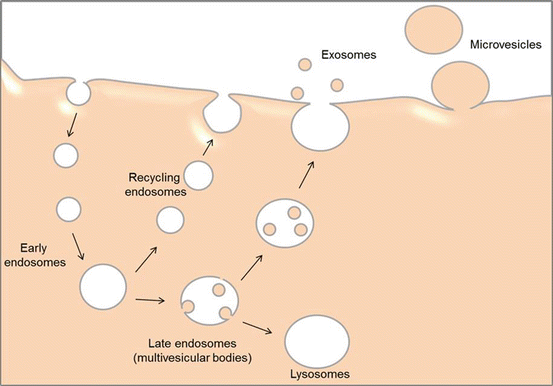

Fig. 2
Exosome and microvesicle formation. Exosomes are a subproduct of the endocytotic pathway originating from endosomes. Endosomes may be classified into early endosomes, late endosomes, and recycling endosomes. When their content is destined for recycling, it is sorted to the plasma membrane via recycling endosomes. When their content is destined for degradation or exocytosis, early endosomes then undergo a series of transformations, namely the formation of 30–100 nm vesicles that bud into the lumen of late endosomes. For this reason, these late endosomes are also known as multivesicular bodies (MVBs) . The late endosomes are then destined to fuse with either lysosomes (content degradation) or the plasma membrane (content secretion). The vesicles released into the extracellular space are exosomes . In contrast, microvesicles originate from the direct outward budding and fission of the plasma membrane
Microvesicles display a biogenesis mechanism quite distinct from exosomes. In opposition to the biogenesis of exosomes , microvesicles originate from the direct outward budding and fission of the plasma membrane . Microvesicles are larger in size (50–1000 nm) when compared to exosomes. However, small microvesicles and large exosomes overlap in size [20]. The biogenesis of microvesicles is an outcome of phospholipid redistribution and cytoskeletal protein contraction. In the plasma membrane, there is a natural phospholipid asymmetric distribution that is tightly regulated by aminophospholipid translocases that transfer phospholipids from one leaflet of the plasma membrane to the other [22]. When there is a significant increase of cytosolic Ca2+ accompanying cell stimulation, translocase function is dysregulated. This leads to a collapse of the membrane asymmetry culminating in surface exposure of phosphatidylserine (PS). Such a process is followed by the release of microvesicles induced by cytoskeleton degradation via Ca2+-dependent proteolysis [2, 20]. Microvesicles were previously described as annexin V positive, but recent evidence based on cryo-transmission electron microscopy (TEM) shows that nearly 50 % of these vesicles express PS at their membrane [23].
In contrast to exosomes and microvesicles , which are physiologically secreted by cells, apoptotic bodies are produced only during programmed cell death [20]. Apoptotic bodies also differ in size and composition from microvesicles and exosomes. They present generally with a larger size (500–4000 nm) and are characterized by the presence of intact organelles with or without a nuclear fragment within the plasma membrane vesicle [24].
The aforementioned features of exosomes, microvesicles, and apoptotic bodies are widely reported and accepted by the international community. However, characterization difficulties related to their size and constitution render the frontier between the different vesicles unclear. Increasing evidence from the literature also indicates that vesicles share common features suggesting that body fluids display a continuum of vesicle types whose properties are sometimes overlapping [25].
Apart from the classification relying on the biogenesis mechanism, there is a parallel classification based on the source of isolation. Indeed, EVs have been isolated from diverse body fluids, including semen [26], blood [27], urine [28], saliva [29], breast milk [30], amniotic fluid [31], ascites fluid [32], and bile [33], just to name a few. In this way, the terms epididimosomes (vesicles from epididymal fluid), prostasomes (vesicles from seminal fluid) [26], matrix vesicles (vesicles in bone, cartilage, and atherosclerotic plaques) [34], synaptic vesicles (vesicles from neurons) [35], dexosomes (exosomes released from dendritic cells) [36], oncosomes/texosomes (tumor cell-derived exosomes) [37], and outer membrane vesicles (vesicles derived from bacteria) [38] have been used.
3 EV Production
EVs are spontaneously produced during cell culture or released in response to a biological, chemical, or physical trigger.
Exosomes are spontaneously released by cells in culture with complete medium. However, as the complete medium naturally contains exosomes, serum must be previously depleted from its bovine-exosome content by ultracentrifugation. Exosome release is strongly influenced by the producer cells. In a comparative basis, the relative amount of exosomes secreted in the conditioned culture media of five different cells or cell lines was evaluated. Mesenchymal stem cells derived from human embryonic stem cells were found to produce the highest amounts of exosomes, followed by the human embryonic kidney cell line (HEK) [39]. The parent cell type from which exosomes are derived may also induce different effects on the recipient cells. The interested reader may refer to a recent review paper [40].
An important parameter not taken into account in previous studies is the fact that EV production and release in the medium is a dynamic process, which comprises EV recapture by cells. It means that the EV number will increase until it reaches a plateau, depending on many parameters such as the cell production, the cell recapture, and the volume of media. It has been reported that the time until reaching the plateau was in the 8–12-h range for breast cancer cells [41].
Apart from the spontaneous exosome release, cells may be stimulated to induce EV release via serum or oxygen deprivation. For example, serum deprivation enhanced EV release from RPMI 8226, U266, and KM3 cells by 2.5-, 4.3-, and 3.8-fold, respectively, compared to culture in complete medium [42]. Hypoxia is another stress factor triggering EV release. For instance, MCF7, SKBR3, and MDA-MB 231 cell culture at 0.1 % O2 with complete medium for 24 h resulted in a nearly twofold increase in exosome release compared to the normoxic control, considering nanoparticle tracking analysis (NTA) data [43]. Both serum deprivation and hypoxia are quite straightforward methods for EV production as no further processing is required to eliminate the vesiculation trigger agent.
Cell activation is also known to trigger EV release. As an example, 20-min stimulation of neutrophils with TNF-a (50 ng/ml), IL-8 (50 ng/ml), and leukotriene B4 (LTB4; 10 nM) induced EV release to double compared with resting cells, according to imaging flow cytometry [44]. Interestingly, EVs released upon cell activation display a phenotype different from EV released under serum starvation. EVs from endothelial cells expressed constitutive markers, such as CD31 and CD105, when the triggering stimulus was serum deprivation. In contrast, inducible markers such as CD54 and CD62E were increased for EVs only when endothelial cells were submitted to TNF-α activation stimulus [5].
EV release is also influenced by chemical agents. Cytochalasin B , which inhibits actin polymerization, is able to induce the release of EVs comprising functional cell surface receptors on the membrane and cytosolic proteins in its inner compartment [45, 46]. For instance, cytochalasin B (2 μM) incubation enhanced EV release by freshly isolated neutrophils by a factor of about 2 [44]. Ethanol is another chemical agent able to enhance EV release both in vitro and in vivo. Hepatocarcinoma cells (Huh7.5 cells) presented an increase in the number of released exosomes in response to ethanol incubation in a time- and dose-dependent manner. The enhancement was near tenfold when cells were incubated at 100 mM concentration, according to NTA data [47].
Recent approaches to produce EVs relate to physical and mechanical methods. Machluf et al. proposed the use of a liposome extruder to transform ghost cells or loaded cells into submicron vesicles [48, 49]. Cell ghosts were produced from rat MSCs and human smooth muscle cells hypotonically treated with tris-magnesium buffer to allow cytosol removal. For EV production , ghosts were extruded through 0.4 μm polycarbonate membranes [49]. However, the paper does not present any data about the efficiency and the yield of this method. W Jo et al. reported the effect of high shear-stress to induce EV release. They designed a microfluidic chip featuring 37 μm sized channels, nearly in the cell diameter. Murine embryonic stem cells were pushed by a syringe pump into the channels at high speed (0.04 m/s). The authors indicate that cell deformation by the shear-stress induced EV budding . The authors argue a highly efficient production of vesicles based on protein assay for EV quantification [50]. Jang and colleagues reported the use of sequential filtration to process cells into vesicles. The process comprises the use of micrometric filters (10, 5, and then 1 μm pore size) to create EVs [51]. The use of centrifugal force (2000 rpm) to constrain cells to pass through filters with micro-sized pores (10 and 5 μm pore) was also reported for EV production . The authors indicate that their technique induces a friction force between the cell and the polycarbonate surface of the filter as both lipid heads and the filter membrane are hydrophilic. The tension makes the plasma membrane elongate until rupture is achieved. The lipid bilayer fragments that are planar immediately after membrane rupture spontaneously self-assemble generating EVs of about 100 nm in size. The yield is about 250 higher than spontaneous exosome release in complete medium, according to protein assay data [52]. As it will be further discussed in the next section, the choice of the protein assay to quantify EV release is controversial. In a related approach, the use of nano-blades in a microfluidic system has been reported to slice cell membrane, creating nanovesicles of 100–300 nm [53]. It has to be noted that a similar chip with similar nano-blades is used for rapid intracellular protein extraction by lysis [54], which supports the assumption that these chips are probably allowing the lysis of the cell, thus freeing organelles. The authors report the collection of 1.5 × 1010 vesicles per million cells, corresponding to 20 μg of protein.
Although there are several methods for EV production , the lack of comparison between them and inconclusive EV characterization data makes it difficult to point out which approach is the most suited for EV production.
4 EV Loading
EVs have been successfully loaded with drugs, nanoparticle, radiotracers, micro (mi)RNA, and fluorescent dyes (Fig. 3). The approaches to confer exogenous imaging or therapeutic properties to EVs roughly fall into three categories. One of them relates to load the parent cell so that the EVs released from it inherit their cargo. The other strategy concerns the loading of EV at the moment they are produced from physically squeezed parent cells. The last method relates to the direct loading of EV after its production and isolation. All three methods will be discussed in the following subsections.
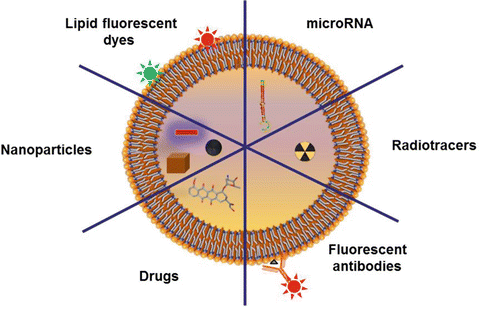

Fig. 3
Engineering extracellular vesicles . Vesicles could be engineered to enclose several molecules, macromolecules, or particles for imaging or therapeutic purposes
4.1 Loading the Parent Cell Before EV Release
In a top-down procedure, our group has engineered nanoparticle-loaded EVs from precursor cells previously loaded with the cargo. For this purpose, parent HUVEC cells were first incubated with nanoparticles and allowed to internalize them. Starvation stress was employed to induce the release of vesicles hijacking the cargo from their precursor cell. By this method, EVs could encapsulate a set of nanoparticles regardless of their chemistry or shape, such as iron oxide nanoparticles, iron oxide nanocubes, gold/iron oxide nanodimers, gold nanoparticles, and quantum dots [55]. Different hybrid nanovesicles were designed: magnetic, magnetic-fluorescent, and magnetic-metallic vesicles, either single component or multicomponent.
Dual-drug/nanoparticle EV loading was also feasible by this method. We demonstrated that vesicles from THP-1 cells could be loaded with iron oxide nanoparticles and different therapeutic agents irrespective to their molecular weight, hydrophobic, hydrophilic, and amphiphilic character [56]. Thereby, magnetic vesicles were loaded with a chemotherapeutic drug (doxorubicin), anticoagulant protein (tissue-plasminogen activator (t-PA)), or two photosensitizers (disulfonated tetraphenylchlorin (TPCS2a) [56] or mTHPC [57].
In a related approach, Mao and colleagues loaded 3T3 or HEK293 precursor cells with quantum dots and hydrophobic calcein acetoxymethyl ester as a model drug. Chloroquine was used to induce lysosome swelling liberating quantum dots into the cytoplasm. The release of EVs inheriting the dual cargo from the parent cells was triggered by cytochalasin B [58].
The strategy of spontaneous cell loading for posterior cargo exported by EVs was also tested for miRNA or nucleic acid EV loading . For instance, HEK293T cells were transfected with enhanced green fluorescent protein (EGFP) plasmid using polyethylenimine. EGFP-positive exosomes could be obtained from transfected cells [59]. This approach has been used to incorporate short interfering (si)RNA [60], miRNA [61], and messenger (m)RNA into exosomes. As mRNA transfection results in protein expression by parent cells, both the protein and the mRNA were found to be packaged into exosomes [62]. Although endosomal sorting complexes required for transport (ESCRT) (which mediates exosome budding in multivesicular bodies [63]) have been shown to preferentially address some nucleic acid sequences (up to 57-fold [64]) to EVs , the obtained EV loading yield may be low. For instance, Kanada and colleagues [65] reported the loading of cells with lipofectamine with either miRNA or plasmids coding for this miRNA in the attempt to enable further exosome and microvesicle loading. The authors indicated that they were not able to detect any loading in the exosome fraction. Only a low loading process with the entire plasmid in the microvesicle fraction was detected.
In case the cargo is a peptide or protein, an interesting strategy consists in fusing the protein/peptide of interest with an EV-enriched protein. For instance, there is a near-100-fold enrichment in lamp2b or tetraspanins in EVs compared to the cell itself. Alvarez-Erviti and colleagues [66] used such an approach to engineer a lamp2b protein fused to the neuron-specific RVG peptide. Thereby, they succeeded in decorating exosomal membranes with this peptide coffering neuron targeting. In a similar approach, a protein cargo of interest may be modified to contain a membrane-targeting sequence (acylation domain, myristoylation domain, prenylation domain, or palmitoylation), so that it will localize in the plasma membrane and also in EVs by consequence. Such plasma membrane anchors have been used to target GFP to exosomes [67].
4.2 Loading During EV Production
Another approach is to load vesicles at the moment they are produced. This strategy mainly relies on physical methods of EV release. For instance, EV loading with doxorubicin was performed by extruding parent U937 monocytic cells through a series of polycarbonate membranes with pore sizes of 10, 5, and finally 1 μm in the presence of doxorubicin [51]. Similarly, rat MSCs and smooth muscle cells were extruded through 0.4 μm polycarbonate membranes in the presence of tumor-necrosis-factor-related apoptosis inducing ligand (TRAIL) in order to produce TRAIL-loaded EVs [49]. In a related strategy, concomitant EV loading and production were reported for the nano-blade approach in a microfluidic system mentioned above. After the cell membrane was sliced, plasma membrane fragments self-assembled enveloping exogenous polystyrene latex beads present in the buffer solution to produce bead-loaded EVs, even if there was some unspecific bead adsorption [53].
4.3 Direct Loading or Decoration of EVs
In addition to the nanoparticle cell loading strategy to produce nanoparticle-loaded vesicles, our group also reported the direct vesicle decoration with nanoparticles . For this purpose, endothelial EVs were incubated with anionic iron oxide nanoparticles that were able to bind to the vesicle surface by electrostatic interaction [68]. EV decoration was also reported with fluorescent antibodies. For instance, human platelet-derived EVs could be double-stained by incubation with annexin V- and platelet-specific fluorescent antibodies (anti-CD61, anti-CD63, or anti-CD62P, respectively) [69]. However, it should be noted that the constant of dissociation of these antibodies may enable them to leave their exosome antigen and interact with endogenous targets, misleading exosome biodistribution investigation.
Drugs may also interact directly with the membrane of EVs enabling loading. This is the case of the lipophilic drug curcumin [70, 71] that may be loaded into EVs via hydrophobic interactions. The same applies to lipophilic dyes such as PKH67 and PKH26 or 1,1-dioctadecyl-3,3,3,3-tetramethylindotricarbocyanine iodide (DiR) to confer EVs with a fluorescent label [43, 72]. However, it is important to mention that lipid dye staining should be performed avoiding lipid excess. Otherwise, lipid dyes can form micelles and be co-purified as a contaminant in EV preparations. EVs may equally be loaded with low-molecular-weight molecules such as paclitaxel and doxorubicin via single-step incubation at room temperature. Drug loading data evaluated by HPLC indicated nearly 7 ng of paclitaxel per 1 μg protein and 132 ng doxorubicin for 1 μg protein [73]. EVs may also be directly loaded with radiotracers. Erythrocyte EVs were incubated with sodium 51Cr-chromate at 37 °C. EVs were then washed under ultracentrifugation to remove free chromate [74]. Loading took place as the tracer is able to cross the erythrocyte membrane and bind to hemoglobin. Once in the erythrocyte, the tracer is reduced by glutathione becoming trapped as the reduced form is not able to cross back plasma membrane [75].
Electroporation was proposed as a quite promising method for EV loading according to a highly cited paper [73] that featured successful siRNA into exosomes using electroporation to knock down a therapeutic target in Alzheimer’s disease. However, 2 years later, Kooijmans et al. [76] published a study explaining that the obtained results were indeed an artifact. In fact, electroporation created metal ions from the electrodes inducing the formation of siRNA aggregates. These aggregates were then co-purified with exosomes . Therefore, siRNA transfer and efficient RNA silencing were not EV mediated, but induced by siRNA aggregates. Once aggregation was inhibited by adding EDTA ion chelator or by coating the electrodes, siRNA was no more co-purified in the exosome fraction. Haney and colleagues compared different techniques to directly load catalase (a large antioxidant protein) into exosomes: incubation at room temperature, freeze-thawing cycle method, permeabilization with saponin, sonication, and electroporation. Sonication and extrusion, as well as permeabilization with saponin, resulted in a high loading efficiency and the obtained vesicles were in a size range of 100–200 nm [77].
In overall, although there are different loading methods, the lack of comparative studies and thorough characterization render it difficult to point out the most effective one in terms of encapsulation efficiency. Vesicle constitution and integrity after the loading process also remain unclear. It seems that there is still a need to develop scalable methods preserving vesicle constitution and integrity while enabling highly efficient loading.
5 EV Isolation
The complexity of biological fluids renders the isolation of EVs extremely difficult. Ultracentrifugation is the most common method to isolate EVs. Typically, centrifugal accelerations of about 200–1500 × g have been applied in order to remove cells and cellular debris. It is necessary to reach 10,000–20,000 × g to pellet vesicles larger than 100 nm, while 100,000–200,000 × g are required to pellet vesicles smaller than 100 nm [25]. A major hurdle of using ultracentrifugation-based purification methods is the impact of G force on vesicles. The acceleration force may lead EVs to fragment, leak their cargo, or become activated. Besides, centrifugal acceleration of 100,000–200,000 × g may induce vesicle fusion and protein sedimentation [78]. All these effects may influence EV properties and purity. In order to avoid cross-contamination between vesicles of different size ranges, it is recommended to perform further purification using a sucrose cushion [16]. Such an additional purification step is expected to eliminate large protein aggregate contaminants, which are sedimented by centrifugation, but do not float on a sucrose gradient [79]. However, this method is time consuming while presenting low yield.
Although ultracentrifugation is the most common purification method, there is currently no consensus about the optimal protocol for the isolation of pure vesicle populations [19]. Other methods may also be considered. New promising techniques are coming to the field, such as the use of ultrafiltration techniques, using 500–1000 kDa filters to retain EVs whereas most proteins are not retained. This technique was used in the first clinical trial using exosomes [80]. Immunoaffinity capture has also been proposed for EV isolation [81, 82]. For this, magnetic beads conjugated with antibodies to bind specifically proteins overrepresented on EVs are used. Tauro and colleagues isolated human colon cancer cell line LIM1863-derived exosomes by means of anti-EpCAM-coated magnetic beads [83]. In this study, immunoaffinity was evaluated to be the best method to capture exosomes, as it was able to isolate a population enriched with exosome markers, and exosome-associated proteins by at least twofold more than ultracentrifugation and density gradient separation. However, this method is expensive and exosomes lacking specific antigens will not be recovered [16].
Immunoaffinity may be conjugated to a microfluidic approach to isolate EVs. Chen et al. reported a microfluidic immunoaffinity method based on their selective binding to anti-CD63-coated surfaces. They demonstrated the feasibility of isolating and extracting exosomal RNA from 100 to 400 μl serum samples within an hour [84]. A cutting-edge technique recently developed couples microfluidics to acoustic purification to isolate EVs. This approach is based on the principle that larger particles move faster as the acoustic force is proportional to their volume. Therefore, larger vesicles and cells move on the side of the channel, while nanometer-sized vesicles are retained in the center flow. This approach is label free and the size cutoff can be controlled electronically in situ, enabling versatile size selection. Although the resolution of this technique allows a 90 % separation yield, it enables EV separation from cells or large debris, but not from protein contaminants [85].
Size-exclusion chromatography was also used to isolate EVs and separate them from contaminating proteins. Böing and colleagues reported that EVs with a diameter larger than 75 nm could be isolated from plasma by single-step size-exclusion chromatography. In contrast to ultracentrifugation, size-exclusion chromatography does not induce vesicle aggregation and there is no risk of protein complex formation induced by acceleration [86]. However, a recent paper described that this method was not as efficient as previously thought, as it leads to low vesicle recovery [87].
Our team described a magnetic sorting method to isolate EVs previously labeled with magnetic nanoparticles . A strong permanent magnet that creates a magnetic field of B = 650 mT, and a magnetic field gradient gradB = 55T m–1 in the volume of the syringe, was used for this purpose. This protocol, dedicated to magnetic EVs, was quite straightforward enabling EV purification in a single step without adding reagents nor antibodies [57].
6 Characterization
Several methods have been used to characterize EVs in terms of size, morphology, and constitution. They will be overviewed herein. However, it is important to mention that none of these techniques singly provide thorough biophysical and biochemical characterization of vesicles and their content [19]. Techniques must be combined systematically in the attempt to perform EV characterization as complete as possible.
Dynamic light scattering (DLS) measurements are user friendly, fast, and rather straightforward. Additionally, DLS instruments also enable the determination of the zeta potential, which is the electric potential difference between the medium and the stationary ion layer bound to EVs [88]. DLS size is determined from fluctuations in scattered light intensity due to the Brownian movement of the particles. The size distribution is calculated by measuring the scattered light fluctuation intensity and applying a mathematical model derived from light scattering and Brownian motion theory [89]. Although DLS gathers many advantages, results may be biased by the presence of large particles in the sample [88, 90] and also by the presence of proteins.
Nanoparticle tracking analysis (NTA) has been increasingly used to provide the size, concentration, and zeta potential measurements of EVs . Particles in a sample are visualized due to the light they scatter when exposed to laser light. The light scattered is then captured by a digital camera. The Brownian motion of each particle is tracked from frame to frame by a dedicated software and the rate of particle movement is calculated through the Stokes-Einstein equation. The technique calculates particle size on a particle-by-particle basis providing important statistical power. EVs from 30 to 1000 nm within a concentration range of 108–109 can be sized and counted with relatively high sensitivity [91]. NTA circumvents one of the key problems associated to DLS (i.e., polydispersity) as it resolves and accurately measures samples featuring multiple size populations well by discriminating peaks of distinct size. NTA has the additional advantage of enabling vesicles to be analyzed in suspension, avoiding shrinkage and fixation artifacts as it may occur for microscopy analysis. Besides, NTA can detect vesicles in a smaller size range compared to conventional flow cytometry (∼300 nm detection limit) [92]. Fluorescent mode detection is also an important asset. Analysis in fluorescence mode provides specific results for labeled EVs . This feature enables users to detect, analyze, and count only a specific population to which the fluorescent marker is bound [91].
Resistive pulse sensing (RPS qNano) operates by detecting transient changes in the ionic current generated by the transport of particles through a nanopore into a nonconductive membrane which separates two fluid cells. As the relative change in current is proportional to the volume of the particle crossing the pore, RPS can accurately determine the diameter of EVs [89]. qNano provides quantitative analysis in samples whose EV size spans from 70 nm to 1 μm at concentrations from 105 to1012 ml [91]. However, pore clogging and pore stability represent some RPS concerns [93].
The size and morphology of EVs have been widely investigated by transmission electron microscopy (TEM) and atomic force microscopy. Atomic force microscopy enables the investigation of EV size and morphology to be performed directly in suspension [94]. However, as the analysis requires surface adhesion, changes from spherical to hemispherical or flat structure may mislead size and morphology interpretation [95]. TEM uses electrons to create an image. Considering that the wavelength of electrons is more than three orders of magnitude shorter than the wavelength of visible light, the resolution of TEM is much higher than that optical microscopy and it can be lower than 1 nm. However, fixation and dehydration are major pre-analytical steps that may affect the size and morphology of EVs [96]. For instance, the cup-shaped morphology described for exosomes is now recognized as an artifact from pre-analytical steps [79]. Despite these artifacts, TEM is a technique of choice for analyzing EVs engineered to encapsulate nanoparticles. Depending on its constitution, nanoparticles are clearly identified in TEM micrographs as electron-dense spots, acting as tracers. This is the case of quantum dots, iron oxide, and gold nanoparticles.
In order to estimate magnetic nanoparticle loading into EVs and other nanocontainers, our group designed a miniaturized straightforward experimental approach [97]. The setup is on a glass slide/coverslip chamber to which a microtip was integrated as a magnetic attractor. The magnetophoretic velocity of EVs moving towards the magnetic tip was observed with an optical microscope connected to a CCD camera and a computer. The quantitative analysis of magnetophoresis enabled to infer both the magnetophoretic velocity and the magnetic content of the nanocontainers. Additionally, the nano-magnetophoresis experiment under fluorescence microscopy provided information on the constitution of the systems, attesting the co-encapsulation of nanoparticles with a fluorescent drug in the core or the encapsulation of magnetic nanoparticles within the membrane of EVs [56, 97].
Flow cytometry represents a high-throughput multi-parametric method for the analysis of EVs in terms of size, concentration, constitution, and fluorescent drug loading. Flow cytometers detect scattered light and fluorescence that are measured by detectors facing forward and perpendicular to the laser. Measurements are performed in a hydrodynamically focused fluid stream at a rate of hundreds or thousands of events per second. Flow cytometry is the most widely used method to detect vesicles in clinical samples and efforts towards standardization of EV measurements have been reported to palliate discrepancies in results when operating on different flow cytometer devices. For instance, Lacroix et al. on behalf of the International Society of Thrombosis and Haemostatic have proposed a sub-micrometer bead (Megamix beads; BioCytex, Marseille, France) gating strategy in order to define EV region in a reproducible and standardized set [98]. In addition to result variability when using different flow cytometer devices, even higher variability is obtained when comparing different characterization methods. In a comparative study, vesicle concentration determination differed markedly depending on the used technique (RPS, NTA, or flow cytometry). The authors indicate that such divergence was imparted by the variability on the minimum detectable vesicle sizes of each technique. They estimated that the minimum detectable vesicle sizes were 70–100 nm for RPS, 70–90 nm for NTA, and 270–600 nm for conventional flow cytometry [93]. Brisson’s team has recently compared EV detection by conventional flow cytometry and electron microscopy . More precisely, data from cryo-transmission electron microscopy combined with receptor-specific gold labeling was confronted to flow cytometry data, in which the detection of EVs was triggered on the forward scatter parameter, taken into consideration EVs labeled with either annexin 5-Fluo or anti-CD235a-Cy5. Results showed that only 1 % of phosphatidylserine-exposing EVs observed by electron microscopy could be detected by conventional flow cytometry [23]. Interestingly, this group showed that flow cytometry analysis with annexin 5-fluorescence triggering enhanced EV detection by a factor 55 when compared to forward scatter triggering [99]. Also using the fluorescence triggering approach, our group pioneered the detection and imaging of EVs by multispectral imaging flow cytometry. Annexin 5-fluorescence detection was combined to m-tetrahydroxyphenylchlorin (mTHPC) fluorescence detection to confirm that this drug was encapsulated into EVs [57].
In addition to the above-mentioned techniques, emerging “omic” approaches (proteomic, lipidomic, metabolomic, and microarray profiling) brought along unprecedented advances in molecular profiling in the attempt to decipher the roles of EVs [91]. Metabolomics has opened new opportunities to provide a global view of metabolic mechanisms related to EVs as it enables the qualitative and quantitative measurement of thousands of small molecules (<2000 Da). Metabolomic profiling can be performed using different high-throughput and high-sensitivity analytical techniques, including gas chromatography/mass spectrometry and liquid chromatography/mass spectrometry [100]. The same techniques have enabled the comprehensive characterization and quantification of the repertoire of lipid and protein species present in EVs via proteomics and lipidomics [101].
Stay updated, free articles. Join our Telegram channel

Full access? Get Clinical Tree


